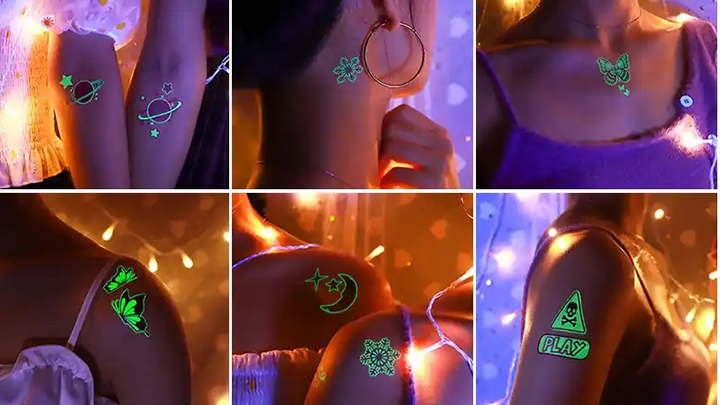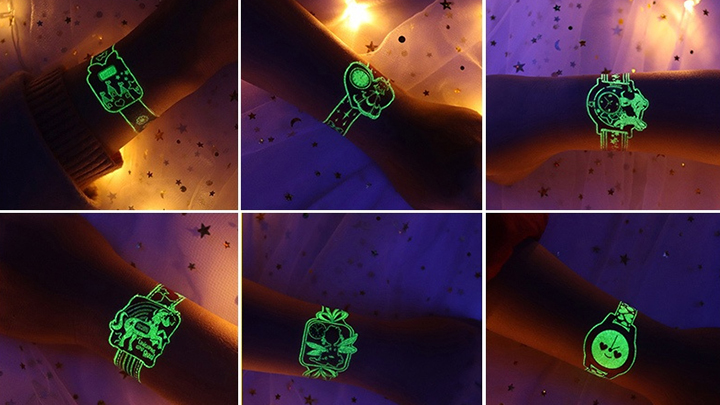Why Do Glow-in-the-Dark Tattoo Stickers Glow?
Glow-in-the-dark tattoo stickers, or luminescent tattoos, are popular for adding a temporary, eye-catching glow effect that’s perfect for parties, festivals, and night events. But what makes these tattoos glow? The secret lies in a type of material that can absorb and store light energy, then slowly release it in the dark. Here’s a breakdown of the science behind why glow-in-the-dark tattoo stickers shine, and how their glow works.
1. The Role of Phosphorescent Materials
Most glow-in-the-dark tattoos use phosphorescent materials to create their glow. Phosphorescent compounds can absorb and store energy from a light source (such as sunlight, LED lights, or even fluorescent lights) and then slowly release that energy as light. This phenomenon is known as “phosphorescence.”
Phosphorescent materials are commonly made from compounds such as zinc sulfide or strontium aluminate, with strontium aluminate being the most widely used in high-quality glow products. This material emits a bright and long-lasting glow, often remaining visible for hours after exposure to light.
2. How Phosphorescence Works
Phosphorescent materials absorb photons (light particles) and store them at an atomic level. When exposed to light, the energy excites electrons in the phosphorescent material, moving them to a higher energy state. When the light source is removed, these excited electrons gradually return to their original state, releasing the stored energy as visible light in the process. This slow release of energy is what causes the material to “glow” in the dark.
This effect differs from fluorescence, which also emits light but only while the material is exposed to a light source. Phosphorescence is unique in that it continues to emit light even after the light source is removed.
3. Types of Glow-in-the-Dark Tattoo Stickers
There are a few types of glow-in-the-dark tattoos, each designed to produce varying glow intensities and colors. Some use ink that’s infused with phosphorescent compounds, while others use a thin layer of phosphorescent material printed onto a transparent sticker. Both types absorb light and glow, though the glow duration and intensity can vary based on the materials used.
For example:
- Standard Glow Stickers: Made from basic phosphorescent compounds, these tattoos emit a soft, short-lasting glow.
- High-Quality Phosphorescent Tattoos: Made with strontium aluminate, these tattoos emit a brighter, longer-lasting glow that can be “recharged” multiple times with exposure to light.
4. Recharging the Glow
After a few hours, glow-in-the-dark tattoos may start to lose their luminosity. To “recharge” them, simply expose the tattoo to a strong light source for a few minutes. Sunlight is ideal, as it provides high-intensity light, but even artificial lights can help rejuvenate the glow. This recharge process can be repeated multiple times until the tattoo eventually fades completely as the phosphorescent materials degrade.
5. Application of Phosphorescent Technology in Tattoos
The process of making glow-in-the-dark tattoos involves incorporating phosphorescent materials into an adhesive tattoo sticker that can safely stick to the skin. Manufacturers make sure these materials are non-toxic and skin-safe, as they are intended for temporary use on human skin. The tattoo is applied like any other temporary tattoo, with a water slide transfer that adheres to the skin’s surface and maintains a comfortable glow without being harmful.
Conclusion
Glow-in-the-dark tattoo stickers owe their magic to phosphorescent materials that can absorb, store, and gradually release light energy, creating a glow effect. This technology is simple yet fascinating, combining the properties of physics and chemistry to produce a fun, temporary tattoo that shines in low-light conditions. With careful handling, these tattoos offer a playful, luminous experience and can be easily recharged to keep glowing throughout the night.




